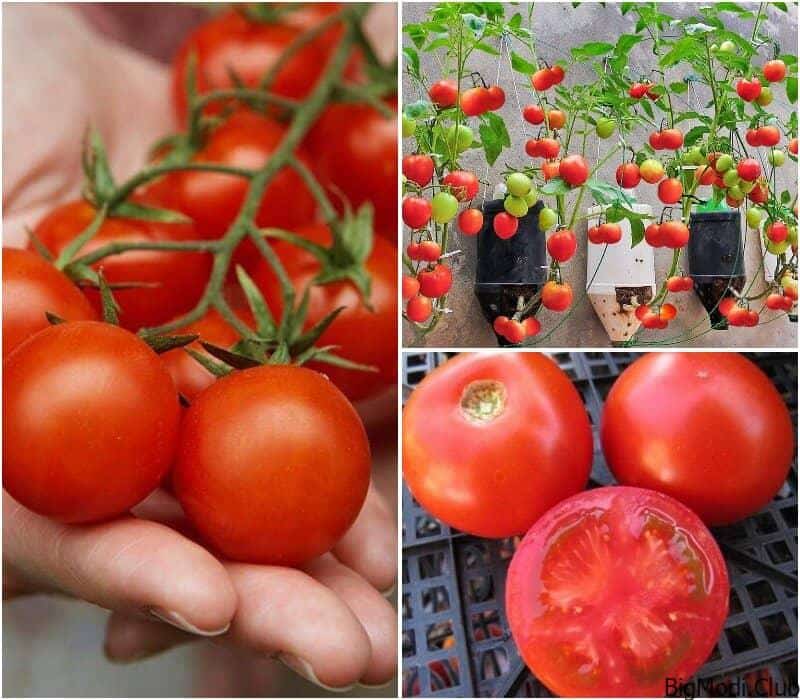If you’re eager to enhance your gardening skills, understanding how to grow tomato plants can be a rewarding challenge. Tomatoes are a staple in many kitchens and a beloved project for gardeners due to their versatile uses and vibrant flavors.
Yet, growing these plants successfully requires more than just planting seeds in the ground. To truly master how to grow tomato plants, it’s essential to grasp their specific needs and care requirements.
From choosing the right varieties and planting techniques to nurturing your plants and harvesting the fruits, this comprehensive guide will walk you through every step needed to ensure a bountiful tomato harvest.
Whether you’re a seasoned gardener or a beginner, mastering these aspects will help you enjoy the fruits of your labor and achieve thriving tomato plants.
How to Grow Tomatoes: A Comprehensive Guide
About Tomato Plants
Tomatoes are renowned for their vibrant flavor and versatility in cooking. However, these plants are quite specific about their growing conditions. They thrive in warm weather and are highly sensitive to frost, classifying them as a tender, warm-season crop. It’s crucial to wait until late spring or early summer to plant tomatoes, except in warmer zones like Zone 10, where they can be cultivated in the fall and winter months.
Tomatoes have a relatively long maturation period, ranging from 60 to over 100 days, depending on the variety. Due to their extended growing season and the timing of planting, many gardeners prefer using transplants rather than starting from seeds directly outdoors. You can purchase transplants from garden centers or grow them indoors from seeds. When selecting transplants, choose young, robust plants that are short, stocky, with dark green leaves and sturdy stems, free from yellowing or spots.
Planting Guidelines
- Site Selection: Tomatoes flourish in full sunlight. In northern regions, aim for 8 to 10 hours of direct sunlight daily. In southern areas, providing some afternoon shade can help tomatoes thrive, especially during the hottest parts of the day.
- Soil Preparation: Prepare the planting site by digging the soil to a depth of about 1 foot. Enrich the soil with aged manure or compost and let it break down for at least two weeks before planting. This ensures that your tomatoes will have a nutrient-rich environment to grow in.
- Crop Rotation: To avoid soil-borne diseases, do not plant tomatoes in areas where related crops, such as eggplants, peppers, or potatoes, have been grown in the past couple of years. This practice helps maintain soil health and reduces the risk of pest infestations.
When to Plant Tomatoes
- Timing: Plant tomatoes only when the spring weather has sufficiently warmed. These heat-loving plants cannot tolerate frost, so ensure that the risk of frost has passed.
- Starting from Seed: If you’re starting from seeds, sow them indoors about six weeks before the last expected frost date in your area. Transplant the seedlings outdoors approximately two weeks after the frost date, once the temperatures are consistently in the mid-50s Fahrenheit (°F).
- Direct Seeding: For those with a long growing season, you can directly sow seeds in the garden. Ensure the soil temperature is at least 55°F, with an ideal temperature of 70°F to promote quick germination within five days.
How to Get more Tomatoes per Plant
- Choosing the Right Varieties: Opt for disease-resistant tomato varieties suitable for your region, such as “Better Boys” or “Early Girls.” Selecting the right variety can significantly affect your yield and plant health.
- Planting Techniques:
- Method One: Strip the bottom leaves of the tomato plant, leaving four to six leaves. Plant the tomato deeply or sideways in a trench, covering the stem up to the leaves. This encourages additional root growth along the buried stem, resulting in a larger plant and potentially more tomatoes.
- Method Two: Use a small PVC pipe next to the plant and water through it. This technique ensures that water and nutrients reach the deepest roots, which can lead to a robust plant with a high yield.
- Soil Amendment: Improve soil quality by adding organic matter, such as composted manure, particularly if your soil is sandy or clay-heavy. This enhancement supports better plant growth and yields.
- Growing in Pots: For container gardening, choose large pots to give the roots ample space. Placing the pot on a cement surface can help retain heat, which is beneficial for tomatoes in cooler climates.
Sunlight and Watering
Tomato plants require at least six hours of full sun each day. Consistent watering is also vital; aim for about two inches of water per week. Adjust the watering frequency based on the plant’s condition and signs of wilting.
Dealing with Pests
Regularly inspect your tomato plants for pests such as tomato hornworms, which can cause significant damage. Promptly remove any pests to protect your tomato crop and ensure a bountiful harvest.
How to Care for a Tomato Plant
Tomato plants, known for their robust flavors and versatility, require attentive care to thrive. Whether you’re a seasoned gardener or a beginner, understanding the essential aspects of tomato plant care can make a significant difference in your harvest. Here’s a comprehensive guide to keeping your tomato plants healthy and productive.
Watering
Watering is crucial for tomato plants as they need consistent moisture to develop healthy roots and produce vibrant fruit. Aim to keep the soil consistently moist but not soggy. Overwatering can suffocate the roots by depriving them of necessary oxygen. A good practice is to water deeply but infrequently, allowing the top inch of soil to dry out between waterings.
Feeding
Young Plants: When your tomato plants are young, their root systems are delicate. After transplanting, it’s best to use only half the recommended amount of fertilizer to avoid overwhelming the young roots. If you’ve enriched the soil with tomato fertilizer before planting, additional feeding may not be necessary until the plants begin to fruit.
Mature Plants: As your plants mature, their nutritional needs increase. Ensure that you continue feeding them to support robust fruit production. A balanced, all-purpose fertilizer or one specifically formulated for tomatoes can help meet these needs.
Supporting the Plant
Staking: To help your tomato plants grow upright and avoid sprawling on the ground, stake them early. Secure the main stems to stakes using soft ties, which will provide the necessary support as the plant grows and bears fruit.
Pruning: Regular pruning is essential for maintaining plant health and maximizing fruit yield. Start by removing small side shoots, or suckers, that grow in the “V” space between the main stem and the branches. After your plant has developed five trusses (side stems with leaves and fruit), pinch off the growing tip at the top of the main stem. This action directs the plant’s energy toward fruit production rather than vertical growth.
For bush varieties, which are generally more compact, pruning is less critical. However, supporting heavily-laden branches with stakes can prevent them from breaking under the weight of the fruit.
When’s the Best Time to Plant Tomatoes
Warm Regions: In frost-free, warm climates, you can grow tomatoes year-round. The consistent warmth allows for uninterrupted growth and fruiting.
Temperate and Cooler Regions: In these areas, the optimal planting time for tomatoes is from late winter through spring. This timing ensures that your plants have the warm conditions they need to thrive.
Cooler Regions – Early Start: For cooler climates, starting seeds indoors is a strategic move. Germinate seeds in small pots under glass or in a mini propagator six to eight weeks before the last expected frost. Transplant the seedlings outside once they have at least three leaves and the weather is consistently warm.
Moon Cycles for Planting: According to astrological guidance, the best days to plant tomatoes in different months are:
- September: 1, 2, 5, 6, 9, 28, 29
- October: 2, 6, 7, 8, 26, 27
- November: 3, 4, 7, 26, 27, 30
- December: 4, 5, 6, 24, 27, 28
How to Prune Tomato Plants
Timing for Pruning: Begin pruning as soon as you notice the first flowers, typically around June or July. Continue this practice once or twice every two weeks until harvest. For best results, prune in the early morning on a dry day to help the plant heal quickly.
How to Prune:
- Locate the Suckers: Find the suckers growing in the “V” between the main stem and branches.
- Remove the Suckers: Pinch off suckers less than 2 inches long with your fingers. For larger suckers, use clean, disinfected pruners to avoid spreading diseases. Make sure the cuts are clean to prevent ragged edges that could damage the plant.
- Dealing with Long Branches: Any low-hanging branches that touch the ground should be either staked or removed. This practice helps prevent bacterial, fungal, and viral infections from spreading to the plant.
How to Harvest a Tomato
To harvest tomatoes successfully, understanding the signs of peak ripeness is crucial. Here’s a detailed guide to ensure you pick your tomatoes at the perfect time.
Determining Peak Ripeness
Color: When assessing tomato ripeness, color is a key indicator. Red, yellow, and orange tomatoes should exhibit their respective bright hues. Pink varieties will take on a dusty rose color. Green types, such as Green Zebra, should be mostly green with just a hint of yellow. For black tomatoes like Black Krim, look for a dusky purple shade.
Smell: A ripe tomato should have a distinct, pleasant tomato aroma. This scent is a good indication that the fruit is ready for harvest.
Squishability: Test the tomato’s ripeness by gently pressing it with your finger. A ripe tomato will yield slightly and then spring back. If the tomato is hard, it needs more time to ripen. Conversely, if the indentation remains, the fruit may be overripe.
Observing Plant Changes
As your tomatoes reach maturity, you might notice that the bottom leaves of the plant begin to yellow and brown. This is a normal part of the ripening process and not a cause for concern.
How to Harvest Tomato Seeds to Plant
Saving tomato seeds for future planting is a great way to preserve your favorite varieties and ensure a continuous supply of fresh tomatoes.
Selecting Tomatoes for Seeds
Choose Heirloom Varieties: Opt for heirloom tomatoes rather than F1 hybrids. Heirloom seeds retain the plant’s characteristics from year to year, making them ideal for consistent results. Leave one or two fruits on the plant until they are overripe to ensure the seeds inside are fully developed.
Harvesting Seeds
Cut and Scoop: Harvest the overripe tomato and cut it in half. Use a knife or spoon to scoop out the seeds. This method ensures that you gather seeds with the potential for successful germination.
Drying the Seeds
Air Dry: Spread the seeds along with any fruit pulp on a small piece of baking paper. Allow them to air dry completely. The gelatinous coating on the seeds does not need to be removed; it will dry and act as a protective layer during storage.
Storing Seeds
Proper Storage: Once the seeds are thoroughly dry, place them on baking paper inside a well-sealed plastic bag. Label the bag with the variety name and harvest year for easy identification. Store the seeds in a cool, dry, and dark place. Properly stored seeds can last up to five years. Avoid freezing them, as extreme cold can damage the seeds.
Advantages of Saving Tomato Seeds
Longevity and Preservation: Saving and storing tomato seeds is an excellent practice because they can remain viable for up to five years. By choosing heirloom varieties, you ensure the preservation of specific plant characteristics. This not only helps avoid the need to purchase new seeds but also contributes to maintaining tomato diversity and cultural heritage.


